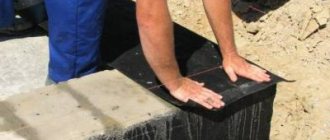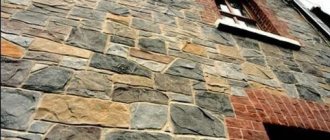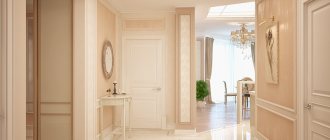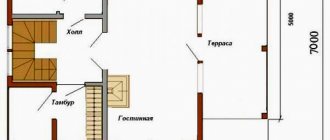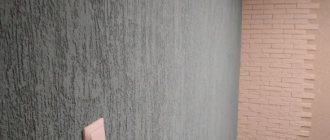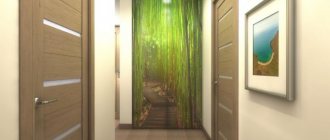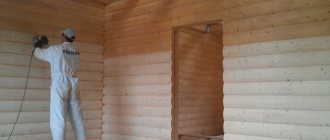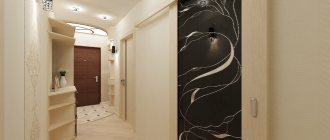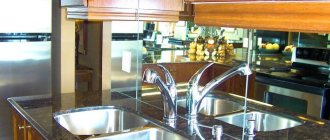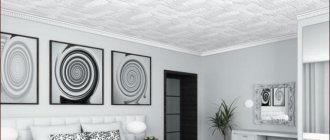Stone decoration of hallway walls is extremely popular and in demand today. This is due to the excellent quality characteristics of decorative stone. Requiring no special preliminary preparation or leveling of the walls before facing, resistant to various types of damage and high levels of humidity, the incredibly impressive stone design will appeal to many people and be affordable.
Decorating the hallway with decorative stone
The walls of the hallway are what catches the eye of any entering guest. Every day the hallway is the very first thing that greets you at home. Therefore, the entrance to the house must have a certain style and be in harmony with the rest of the design of the apartment or house. Which of the many cladding options will be chosen is up to you. We will just reveal a few nuances, knowledge of which will protect you from possible mistakes:
- Often there is not enough natural lighting at the entrance to the apartment. By using materials in warm colors, you will avoid creating a gloomy room.
- Decorating a small corridor with decorative stone and small tiles will visually increase its size. Large elements will visually weigh down an already small space.
- The problem with a wall that has a geometrically complex location can be solved by using flexible stone. The sheets cut and bend well, which makes it possible to cover even rounded corners.
Decorative stone in the house Source catalog6.ru.net/
- Decorative stone is considered a self-sufficient material. You should not add unnecessary decoration (paintings, shelves, photographs) to it. It will be better if the wall remains free.
- The textured surface is highlighted by installing additional vertical lighting. The maximum effect is achieved by using rays propagating from bottom to top.
- You can create an optical illusion and enlarge a small hallway space using the opposite mirror wall.
- The natural warmth of wood will be an excellent complement to the coolness of the stone. Both types of material, when used in the same room, merge into a single harmony.
In warm colors Source krrot.net
Natural stone tiles on the floor Source www.keramis.com.ua
Types of coating
When you see a hallway trimmed with decorative stone, you can’t even imagine what variety of materials can be used for its cladding. Both natural and artificial elements are used. Real stones give the room an original, unique charm; each of them has its own individual texture and coloring. Due to their high cost and heavy weight, they may not always be applicable. In this case, analogues take over.
Stone-effect wallpaper in the hallway Source mebel-go.ru
Outwardly, they are similar to natural materials; it is almost impossible to find differences at a superficial glance. Modern technologies make it possible to create an imitation of any texture and color scheme that can be matched to any style. This becomes the reason for the popularity of such cladding; moreover, the list of materials from which decorative stone is made is impressive:
- Gypsum.
- Cement-sand mixture.
- Agglomerate.
- Granite, marble and quartzite crumbs.
- Porcelain tiles.
- Plastic.
- Flexible sandstone.
Wall decoration: stone imitation Source stenaprofi.ru
Natural stone is most often used for cladding external facades. For interior decoration, it is more practical to use artificial. Conventionally, all materials can be divided into 2 categories: sandstone and decorative tiles.
Stonework in the hallway Source sam-sebe-dizainer.com/
Modern interior Source modernplace.ru
See also: Catalog of companies that specialize in finishing materials.
Finishing with flexible stone in the interior of the hallway
Sandstone is not as famous as gypsum or plastic, but the number of its fans is increasing every year. This is explained by its wide range of applications and amazing results. Used for interior and exterior decoration. It is lightweight and practical, the thickness of the canvas does not exceed 7 mm, consists of three layers:
- Non-woven fabric or flexible fabric base.
- Adhesive (often a solution of epoxy resin is used).
- Fine chips of marble, quartz or granite.
Flexible stone Source hundred-worries.com
Supplied in rolls, tiles or standard slabs 1,000x2,500 mm.
Installation rules
Decorating a hallway with decorative stone of this category is similar to wallpapering. The only condition is to apply glue only to the wall, while the material remains clean. The procedure is as follows:
- The composition is leveled over the working surface with a spatula (thickness, according to the manufacturer’s recommendations).
- A sheet (roll) of flexible stone is applied.
- Corrected in plane and smoothed with a roller.
The process of finishing a wall with flexible stone Source realty.mail.ru
It is fixed using a special glue for flexible stone; if you couldn’t buy one, you can use another one with high adhesive properties.
When installing, follow the rules depending on the type of material used:
- When gluing roll material, start from the corner or extreme point. Move from top to bottom.
- Adjacent strips are glued end to end; choosing the “overlapping” method requires the use of a hair dryer, which heats the edges of the strips. After obtaining a paste-like mass, smooth it with a roller. This achieves a complete, seamless surface.
Hallway with fireplace and sitting area Source roomester.ru
Wall decoration in a modern style Source remoo.ru/
Laying method “Wild stone”
The originality of the method is that the finished surface is similar to a wall built from untreated stone. Laying is carried out similarly to the previously described method. The difference is that at the preparation stage, sheets of decorative stone are cut in the form of large boulders with an irregular geometric shape. This is done with ordinary scissors or a stationery knife.
Partial finishing with stone-like facing tiles for interior work Source nacar.ru
The finished “stones” are distributed on the wall with a deliberate gap of 2-3 mm. Each element is carefully pressed with a roller. After complete drying, the seams are treated with grout. The final step is to apply a water-repellent primer.
Interior in minimalist style Source design-homes.ru
Advantages and disadvantages of flexible stone
Let's reveal the positive and negative aspects of the material. Among the advantages we note:
- Absolute environmental safety. Only natural ingredients that do not have harmful impurities are used in production.
- Easy to maintain and install. The ability to do the work yourself.
- High functionality and versatility. Due to its high elasticity and minimal thickness, flexible stone is successfully used for cladding round and curved surfaces.
- Seamless installation or a wall made of imitation chopped granite – the possibilities for interior design are varied.
- Light weight.
- Not flammable, does not support combustion processes.
- High light transmittance. Sandstone is used to decorate floor and wall lamps.
- Air and vapor permeability, which is favorable for houses made of wood, aerated concrete or other “breathable” materials.
Example of artificial masonry Source www.avito.ru
Texture of flexible stone Source hundred-worries.com
It would take a long time to list the advantages of sandstone stone - we have named only the most significant. Among the shortcomings of the material, pay attention to the following:
- The high price compared to other materials is the main disadvantage of flexible stone. A high-quality coating from a trusted manufacturer will cost 1,500 rubles. per square.
- It is necessary to have a perfectly flat surface “under the wallpaper”. Otherwise, it will not be possible to realize your plans.
- A large amount of uncertified material (counterfeits).
Poor-quality coating does not bend well, can break at bends, does not stick well, and crumbs fall off. Having saved on the purchase, you will be disappointed in the material and will be forced to remodel the hallway.
Decorative stone tiles in the hallway
Decorating the hallway with decorative stone is considered a trend of past and future seasons. Natural textures have been and will continue to be popular. This is facilitated by a wide selection of materials.
Arch trimmed with stone Source freepatriot.club
Natural elements
Natural stone tiles can have a textured or smooth surface. In order to increase the effect, varnish or glaze is applied to it. It is distinguished by its high price and heavy weight. Among the models presented on the Russian market, the most popular are those made from the following materials:
- Onyx.
- Marble.
- Granite.
- Basalt.
Other materials are imitation of natural stone with different compositions, characteristics and prices.
Example of wall decoration Source www.geotiles.com
Ceramic tile
Ceramics with imitation of natural stone are one of the most common types used for interior and exterior cladding. It has a huge variety of textures and shades. Capable of displaying the smallest relief elements, transitions and stone veins. Ceramic decorative stone in the hallway can hide imperfections in the form of uneven walls or, on the contrary, focus attention on the merits of the design.
Stone wall Source okoyogurt.com
Successfully used for combined surfaces. It is made under the influence of high temperatures after mixing quartz sand, clay, dyes and binding elements.
Gypsum products
The composition includes a mixture of natural, environmentally friendly gypsum with polymer additives. They are light in weight, resistant to moisture, hygroscopic, susceptible to destruction under mechanical stress, and fragile. They have high heat and sound insulation properties. It is used to cover the entire wall surface or accentuate individual areas: doorways, arches, niches.
Stone-like gypsum tiles in the interior Source www.avito.ru
Clinker
This is a real brick with a thickness of 1-3 cm. Due to its composition and manufacturing process, it can be used indoors and outdoors. It has properties identical to ceramic tiles: good strength, rigidity, resistance to mechanical stress, and is not susceptible to reaction when interacting with household chemicals.
Brick walls Source studiorospis.rf
Porcelain tiles
In terms of performance characteristics, it is practically not inferior to natural stone. It is considered the highest quality analogue in terms of practicality. It has a high wear resistance class with a service life of up to 100 years.
Decorating a hallway in light colors Source www.architonic.com
Conglomerate
It is made from chips of natural stone: marble, onyx, basalt, malachite. The tile is able to imitate most natural minerals. It is rigid, wear-resistant, and not subject to mechanical stress. It is used for cladding walls, hallway floors or other premises.
Marbled stone floor Source sl.aviarydecor.com
Plastic panels
Plastic wall panels for decorative stone decoration of the hallway have low cost and high performance quality. Thanks to these characteristics, the material is popular with consumers. There can be several types:
- Rack and pinion - 2-3 m long, 0.1-0.5 m wide. Mounted according to the tongue-and-groove principle.
- Tile - similar in appearance to ceramic tiles. The size does not exceed 1 m2.
- Sheet - has large dimensions, is mounted without sheathing, using glue.
Modular decorative wall coverings Source xn—-7sbarf4ac3as7a6f.xn--p1ai/
Thanks to a huge selection of materials, it is possible to create an original interior with minimal financial investment.
What material is it made from?
Artificial substitutes are created from natural ingredients. Natural minerals naturally accumulate and harden, in this case the process is regulated by man. The result is environmentally friendly products that are not harmful to health.
Gypsum blanks
Gypsum blocks are popular. The stones are light and can be painted in any shade.
Due to their low weight, the blocks can be used on any walls, regardless of the finishing material.
Gypsum tiles
Disadvantages: fragility to mechanical stress, instability to moisture. If it gets too wet, the finish may collapse.
The hallway is faced only with protective impregnation and acrylic varnish.
Elements from egg trays
Some people make stones from available household items. For work you will need measuring tools, a stationery knife, glue, paint.
Cut straight cardboard blocks. Egg trays are torn by hand, leaving a slight relief, but smoothing out strong protrusions.
Example of finishing from egg trays
Pieces of trays are gradually glued to the cardboard base. Additional gluing with thick paper napkins will help to bring the surface of the workpieces as close as possible to the stone. The napkins need to be wrinkled first; they can be glued with regular PVA glue.
Painted with one color with a transition of shades, or several. It is recommended to use acrylic paints with a water-repellent effect and varnish after completion of the work.
Interior ideas
There can be only 2 ways to use stone in the interior of a hallway: veneer the entire wall or a separate part of it. A doorway, arch, corner or other element highlighted with stone will become more expressive. Confirmation of this can be seen in the photo of the best options:
In antique style Source www.zelremstroy.ru/
Cladding of doorways.
Partial decoration of the hallway with artificial stone Source mirkam22.ru/
The chaotic distribution of gypsum tiles makes the room original.
Design of the hallway of the room Source dekordelisi.com
The clinker on the outer and inner corners, near the stairs, performs not only an aesthetic, but also a practical function - it protects the walls from damage (abrasion).
Good hallway lighting Source www.pinterest.com
It is not necessary to emphasize the elements of the walls. Using imitation natural stone, you can focus attention on the mirror and original lighting.
The first option (complete decoration of the hallway walls with decorative stone) will add chic, elegance, and beauty to the room:
Hallway with loft style Source prihozhaya.guru
Corner finishing Source www.houzz.es
Dark long corridor Source www.ornamentalstone.ru/
Stone-like wall in the interior Source 2gis.ru
Original finishing option Source www.casavaga.ru/
Decorative plaster Source www.pinterest.com
Beautiful interior of a home hallway Source www.hros.ru/
How to choose shades
Color sets the mood for the entire interior. For a narrow and long hallway, deprived of natural light, it is better to choose light colors. First of all, you need to choose the main color. 60 percent of the interior should be painted with it.
Pearl with coffee
You can paint the walls in white pearlescent color. Furniture and doors will be coffee. Gold-painted door handles, hanger hooks, and decorative elements of furniture and lamps will help “revive” these two shades.
Sand with terracotta
The walls in the corridor can be made in sand color. Floor materials are selected in a terracotta tone. Furniture can be light brown or beige.
White is considered neutral. Suitable for painting walls. It can be combined with sky blue.
Violet with pink
The walls can be painted pale pink. Furniture and doors may have a violet tint. The floor in such an interior can be coffee-violet.
Apricot with eggplant
Delicate apricot color is suitable for walls. The floor may have an eggplant tint. The furniture is chocolate or gray-brown.
Red-orange with gray-yellow
Red-orange accents in the interior are in harmony with pale apricot walls and gray-yellow furniture. The floor may have a chocolate tint.
Khaki with olive
Khaki-colored flooring and gray or white furniture will go well with olive-colored walls. Decorative elements may be black.
Lime with turquoise
The hallway may have turquoise walls, white ceiling and furniture, and gray floor. Decorative elements may have a lime tint.
Creamy with dark saffron
The yellowish-creamy walls are in harmony with the saffron floor. Furniture can be white or light brown.
Zoning the hallway with decorative stone
The heaviness of the stone is felt not only physically, but also visually. This must be taken into account already at the planning stage. Abuse of material can make the hallway an overly heavy and gloomy room. The only exception is the immediate task of creating the atmosphere of the entrance to a castle or cave. Therefore, it will be enough to zone a certain area.
Wall decor Source www.pinterest.com
An option for partially finishing the hallway with light-colored decorative stone.
Large corridor in the house Source www.archilovers.com
A wall lined with antique stone, with a combination of light colors.
Wall decoration with artificial stone Source yellowhome.ru
Steps imitating layers of rock.
Stone on the wall in the hallway Source prihozhaya.guru
Zoning of the front door, made using the chaotic laying method.
Large mirror in the hallway Source www.dizainvfoto.ru
A positive effect is achieved by edging the mirror. By adding harmonious lighting from a modest room, you will create a solid, expensive hallway.
Decorative wall decoration in the hallway in the loft style Source yellowhome.ru/2019
To create natural coziness, it is enough to zone just one wall.
Artificial stone in a modern interior Source yellowhome.ru/2019
Imitating natural stone on the hallway ceiling is quite a bold decision.
Decoration in white Source prihozhaya.guru
Replacing strict geometric corners with rounded ones and their advantageous zoning.
If the corridor has stairs
When decorating such a room, you need to remember that the colors of the walls, floor and stairs must be combined with each other.
Lighting
Lighting fixtures are selected to match the style of the room. For classics, a sconce on the wall is suitable. The Art Nouveau room is decorated with spotlights.
Stylistics of the ladder
This interior element performs not only a functional, but also a decorative task. The style of the staircase should match the design of the house.
Strength of glass materials
The glass staircase does not weigh down the interior, but, on the contrary, gives it lightness and airiness. Transparent steps make the room brighter, and they are made of thick laminated glass.
The advantages of decorating the hallway with decorative stone
Decorating the hallway with decorative stone has the following advantages:
- Combines harmoniously with almost any style. Able to fit favorably into the interior of a modern apartment.
- It has a huge range of textures, patterns and color shades.
- Most of the materials used to make decorative stone are classified as environmentally friendly.
- It compares favorably with natural stone in price, weight and ease of installation.
- Not susceptible to infection by fungal parasites.
Decorating the hallway with stone and wallpaper Source www.pinterest.com
The only disadvantage of decorative stone is its shorter service life compared to natural stone. Most manufacturers provide only 10-15 years (depending on the type of material) for the operation of their products.
With proper selection and care, the disadvantage is easily overcome and can last much longer than the period stated by the manufacturer.
Finishing with rough textures Source happymodern.ru/
Selection tips depending on styles - table
| Name | Hue | Length, height, thickness, cm | For what interior? | |
| Tien Shan 30 | Gray beige golden | 48.6x9.8x4.6 29.2x9.8x4.6 19.3x9.8x4.6 | Classic, modern, Mediterranean | |
| Tien Shan 27 | Beige gray golden | 48.6x9.8x4.6 29.2x9.8x4.6 19.3x9.8x4.6 | Mediterranean, Venetian, modern classics | |
| Luxembourg 15 | Sand brown | 24x7 | Modern, country, loft | |
| Mistral 1 | Beige, very light | 19x5x1 | Modern, loft | |
| Nordic 3 | Golden beige with tan marks | 23.8x6.9x1.3 | Modern, country, loft |
Stages of finishing a hallway with decorative stone
The finishing technology depends on the type of material used. One involves fixing to uneven surfaces, the other to carefully leveled ones. For example, flexible stone in the interior of a hallway requires perfectly smooth walls. The use of gypsum and ceramic tiles allows for slight plane deviations. Leveling is done by adding a thickness of glue. Some types of plastic panels are mounted on the sheathing. As a clear example, let’s omit the technology for preparing (leveling) the base and visually consider the stages of cladding with decorative stone:
Laying tiles with glue Source www.hogyan-kell.com/
Natural stone Source stroyday.com
The glue dries within a few minutes, so it is applied in a thin layer. Leveling is carried out with a notched trowel. It is more convenient to start laying from the bottom row.
Having placed the tile against the wall, you need to slightly move it back and forth. This will distribute the adhesive composition over the entire surface.
Laying is carried out end-to-end or with gaps (seams), which will subsequently be treated with contrasting grout. The technique is selected depending on the desired result: to create a smooth surface and straight seams (brickwork), the boundaries of the contours are drawn.
Wall tiling Source bezkovrov.com
To maintain uniform vertical gaps, beacons (crosses) for tiles are used.
Stone tiles in the hallway Source remoo.ru/
Having completed the surface covering, if necessary, treat it with paint or varnish.
At the final stage, distribute the correct lighting. The full effect will be achieved only in this case. For example, 2-3 wall sconces with yellow light will add warmth and comfort to the hallway. Cold, white lighting will add fundamentality and rigor.
Natural stone tiles in the hallway of a private house Source remoo.ru/
Accent wall Source remoo.ru/
Options for non-standard shaped rooms
Design options may also depend on the shape of the corridor. If it is L-shaped or square, it makes sense to visually divide the space into two parts and, accordingly, choose a different design for the floor of each. You can use a traditional combination of porcelain stoneware with wood or several types of tiles. Floor coverings with fine patterns, imitation parquet or brickwork, or bricks laid out in a herringbone pattern will look good.
6 photos
Instagram @solo_design_studio
Instagram @luxehousedesign
Instagram @dizain_interior_ufa
Instagram @vastu_huligan
Instagram @dom_tvoej_mechty
Instagram @alesya_shabarina
